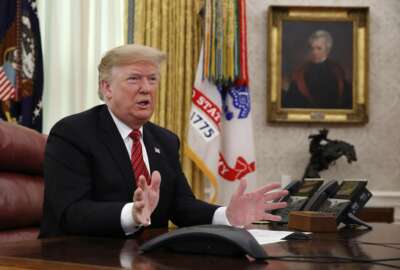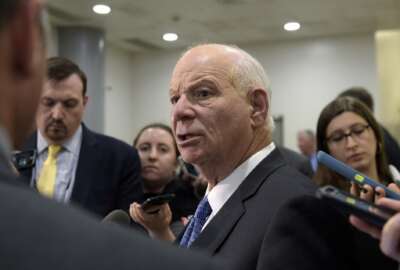
Why political appointees are getting a pay raise and most career feds, for now, aren’t
The Office of Personnel Management has told agencies not to give political appointees a $8,000-to-10,000 pay raise originally set to go into effect Saturday. Bu...
Best listening experience is on Chrome, Firefox or Safari. Subscribe to Federal Drive’s daily audio interviews on Apple Podcasts or PodcastOne.
UPDATED on Jan. 6, 2019 at 5:00 p.m. to reflect the Office of Personnel Management’s new memo encouraging agencies to hold off on giving their political appointees a raise.
President Donald Trump said Friday afternoon he’d consider asking his cabinet to reject a political appointee pay raises originally set to go in effect Saturday.
An executive order froze pay for career civilian employees this year at 2018 levels. But it also provided a $8,000-to-10,000 raise for the vice president and political appointees, unless Congress does something about it.
But the raise for the vice president and political appointees is yet another consequence of government’s collective failure to pass appropriations bills or provide stop-gap funding for federal agencies ahead of the current partial government shutdown.
Regardless of whether the consequences were intended or not, the optics look bad. Some 800,000 federal employees are furloughed or working without pay during this partial shutdown, and President Donald Trump confirmed his decision last week to freeze their pay for all of 2019.
Congress has frozen pay for political appointees at least since 2014, when lawmakers included a provision holding pay rates at 2013 levels in a 2014 omnibus. The provision detailing the pay freeze has become practically standard appropriations language since then, and it has appeared in subsequent spending bills and continuing resolutions for the past four years. The Office of Personnel Management has issued separate memos describing the pay freeze every year.
“The pay freeze will end on the last day of the last pay period that begins in calendar year 2018 (i.e., January 5, 2019, for those on the standard biweekly payroll cycle),” Mark Reinhold, OPM’s associate director of employee services, wrote in an April 2018 memo to agency human resources personnel. “Future congressional action will determine whether the pay freeze continues beyond that date.”
But Congress didn’t act, meaning that raises for a group of political appointees were set to kick in. The president’s most recent executive order implemented automatic pay adjustments for the Executive Schedule, as described in Title 5 statute.
The situation is similar to the scenario most career federal employees live and breathe every year. A formula set into law dictates how much more federal employees could earn during every given year. Congress can intervene, and the President can submit an alternative pay plan for General Schedule employees.
The President, however, can’t submit an alternative plan of his own to differ with the statute dictating raises for political appointees. Therefore, Congress must act on its own if it disagrees with automatic pay adjustments for political appointees.
This applies to employees serving in an Executive Schedule position, a political appointment and a chief of mission or ambassador at large. It also covers non-career appointees in the Senior Executive Service paid at or above a specific Executive Schedule rate of $164,200 in 2018, as well limited term appointees or certain limited emergency appointees in the SES.
Career federal employees also saw their pay frozen for three consecutive years during the Obama administration.
Will political appointees actually get that raise this year?
But Trump may not even need to tell his cabinet members not to accept a raise this year.
The Office of Personnel Management late Friday issued new guidance encouraging agencies to hold off on giving their political appointees a raise.
“In the current absence of congressional guidance [OPM] believes it would be prudent for agencies to continue to pay these senior political officials at the frozen rate until appropriations legislation is enacted that would clarify the status of the freeze,” Margaret Weichert, the agency’s acting director, said in a memo.
Like the current situation with General Schedule pay this year, there is a chance — possibly a strong one — that political appointees won’t see a raise in 2019.
The House omnibus bill, which members passed Thursday night, freezes pay for the vice president, political appointees and non-career senior executives. Even though the White House and Senate Majority Leader Mitch McConnell (R-Ky.) have said that bill is a “non-starter,” whatever legislation Congress passes to end the partial shutdown will likely include that exact pay freeze provision that’s appeared in spending bills for the past four years.
Congressional appropriators had discussed the possibility of lifting the pay freeze for appointees this past year. The Senior Executives Association estimated a lift on the pay freeze would cost roughly $300 million over 10 years, Jason Briefel, the organization’s executive director, said.
“It’s definitely a slap in the face for federal employees … even if it is temporary,” Briefel said.
“It’s bad policy to have a pay freeze for anybody,” he added. “I think the argument can be made that having the pay cap in place makes it harder for political folks to want to come into government or stay longer in government.”
The original House appropriations bill actually did remove the provision blocking the pay freeze. The Senate version kept it in place.
OPM has also reminded agencies they can continue to grant performance-based pay and promotion increases to their employees, depending on available funding.
But the partial government shutdown — and the budget uncertainty leading up to the lapse in appropriations — distracts agencies and prevents them from making long-term human capital plans for performance bonuses and other recruitment and retention initiatives, Briefel said.
The Trump administration this year advocated for the creation of a new workforce modernization fund in the 2019 financial services and general government appropriations bill. The goal behind the new workforce fund was to give agencies the flexibility to reward top-performing employees, but that fund didn’t appear in the House or Senate version of that bill.
Copyright © 2024 Federal News Network. All rights reserved. This website is not intended for users located within the European Economic Area.
Nicole Ogrysko is a reporter for Federal News Network focusing on the federal workforce and federal pay and benefits.
Follow @nogryskoWFED
Related Stories





